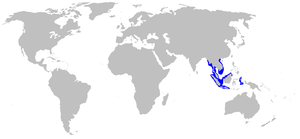Indonesian bamboo shark
| Indonesian bamboo shark | ||||||||||||
|---|---|---|---|---|---|---|---|---|---|---|---|---|
| Systematics | ||||||||||||
|
||||||||||||
| Scientific name | ||||||||||||
| Chiloscyllium hasseltii | ||||||||||||
| Bleeker , 1852 |
The Indonesian bamboo shark ( Chiloscyllium hasseltii ) is a shark from the bamboo shark family (Hemiscylliidae).
features
The species reaches a maximum length of 61 centimeters, adult animals usually measure between 40 and 50 centimeters. The body and tail are slender like other species of the genus, it has no ridges on the sides of the body. The shark is usually evenly colored gray and has no pattern on the body, the fins can be shaded a little darker. In the young animals there are clear saddle spots with dark borders and dark spots, the fins also have dark spots.
The mouth lies clearly in front of the eyes, which are quite large for the species. Both the dorsal fins and the anal fin start very far back on the body. The first dorsal fin starts above the middle of the pelvic fins and the beginning of the anal fin is far behind the end of the second dorsal fin. The rear edge of the dorsal fins is straight to slightly convex.
distribution and habitat
The Indonesian bamboo shark lives in the eastern coastal area of the Indian Ocean from Burma to Vietnam and in the Indonesian area from Sumatra to New Guinea . Thus it joins the area of the gray bamboo shark ( C. griseus ), with which it is often confused.
It lives on the continental shelf near the coast and occurs at depths of up to 12 meters.
Way of life
Like related species, the Indonesian bamboo shark feeds primarily on invertebrates. The species is egg-laying ( oviparous ) and lays small, oval eggs, which it attaches to plants on the sea floor. The young sharks hatch with a length of 9 to 12 centimeters and the animals reach sexual maturity with a length of 44 to 54 centimeters.
Relationship to people
The small sharks are classified as harmless to humans due to their small size. It is often caught by inshore fishermen as bycatch , where it is used as food, and can be affected by overfishing and major changes in its habitats near the coast, particularly coral reef destruction . Since little is known about this shark's way of life and reproduction, it is believed to be sensitive to increased fishing pressure. The International Union for Conservation of Nature (IUCN) puts the species on the early warning list (“Near Threatened”) of endangered species.
supporting documents
- ↑ Chiloscyllium hasselti in the IUCN Red List of Threatened Species 2010.2. Posted by: White, WT, 2008. Retrieved July 2, 2010.
literature
- LJV Compagno : Sharks of the world. An annotated and illustrated catalog of shark species known to date. Volume 2. Bullhead, mackerel and carpet sharks (Heterodontiformes, Lamniformes and Orectolobiformes). FAO Species Catalog for Fishery Purposes. No. 1, Vol. 2. FAO Rome 2001 ( full PDF ), (species portrait )
- Leonard Compagno, Marc Dando, Sarah Fowler: Sharks of the World. Princeton Field Guides, Princeton University Press , Princeton and Oxford 2005, pp. 166-167, ISBN 978-0-691-12072-0 .
Web links
- Indonesian bamboo shark on Fishbase.org (English)
